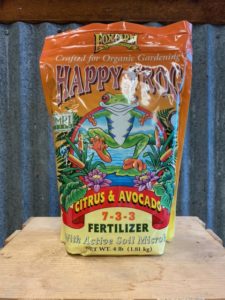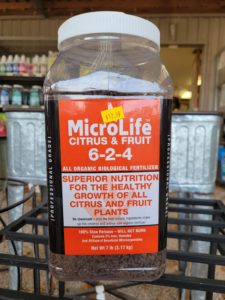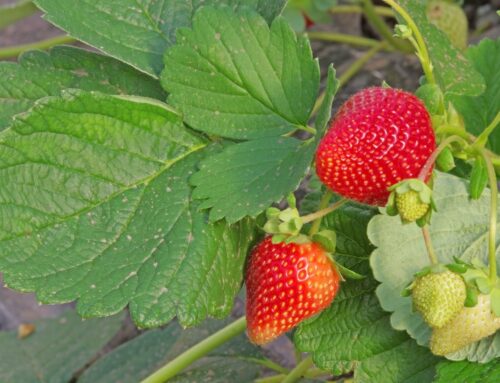There is nothing better than the smell of citrus blossoms in late winter and early spring. The popularity of citrus has increased as many homeowners are creating urban backyard orchards in Central Texas. Commercial citrus operations are typically found in the Lower Rio Grande Valley where the threat of hard freezes is lessened. In fact, Texas is ranked 3rd in US citrus production. You can have citrus in our area as long as you choose the right variety, put it in the right place, and pay a little attention to their care and maintenance requirements.
Most citrus are grafted onto a cold hardy trifoliate orange (Poncirus) rootstock. They usually bloom anywhere from late fall to early spring, and occasionally you will still have ripening fruit on the plant as it is blooming and setting fruit for the next year. ‘Carrizo’ rootstocks are a trifoliate orange rootstock cross which gives trees a little faster growth rate and also cause them to get a little taller. Occasionally you will find citrus grafted on a ‘flying dragon’ root stock, which is a dwarfing root stock. Plants grown on these root stocks will maintain a smaller size with full-size fruit, and are well suited to growing in containers.
Best Varieties: New varieties of citrus are being introduced into Texas markets that are touting to be more cold-hardy than the old standbys. Arctic Frost and Orange Frost Satsuma Oranges are grown on their own rootstocks. If they freeze back to the ground, the plant will grow back from the roots as the same plant. This is exciting news for Central Texas because it means we have a better chance at successfully raising citrus in our landscapes and in containers. We recommend that if you want to be successful at growing citrus in our area, stick with cold hardy varieties or be prepared to grow in containers that are protected or moved indoors in the winter. “In ground” citrus really does better from San Antonio southward.
Oranges and Grapefruit: True oranges (not Satsuma oranges) and grapefruit are not cold tolerant in our Central Texas climate. There may be some varieties that have a greater cold resistance than others, but unless you have a warm microclimate to protect them from hard freezes, they will most likely not survive in the ground here. Keep them in pots and move in for any freeze.
Satsuma Oranges: ‘Artic Frost’ Satsuma oranges are considered to be more cold tolerant than most Satsumas, and will take temperatures down to 25 degrees or lower. These happen to be my favorite. There are many other varieties that ripen early enough to avoid freezing weather. You can grow several different varieties which ripen at different times in the fall to winter, which spreads the harvest season out longer.
Lemons: The best lemon variety for our area is the ‘Meyer Lemon’. It is thought to not be a true lemon but actually a cross between a lemon and a satsuma orange. Meyer lemons differ from most citrus in that they continue to flower and fruit throughout the growing season, and may have fruit ripening at different times. You will see plants labeled ”Improved Meyer Lemon” as well, and this simply means that it is a Meyer Lemon that has been “cleaned” of any viruses the original Meyer Lemon may have had. All Meyer Lemons grown now are the “Improved” variety.
Lemon Drop: A new variety of citrus called ‘Lemon Drop’ is actually a cross between a lemon and a kumquat. The fruit are about the size of an egg, and taste more like a lemon, with a sweet edible rind.
Mexican Limes: Mexican limes are great for our area. There is also a ‘Thornless Mexican Lime’ that also does well here. These are also known as Key Limes. Grow in pots, as they are not cold hardy here.
Pruning: Pruning is rarely necessary on fruit trees. Only prune your citrus trees to control tree size or to remove dead, diseased, or damaged wood.
Planting: Citrus trees prefer well drained slightly acidic soils but will tolerate a soil pH range of 6 to 8. They do well in a container as long as you protect the plant and more importantly, the roots, from freezing weather. Citrus need at least 4-6 hours of direct sun for the best fruit production and healthy growth. To grow your citrus in a pot, choose a quality potting soil, such as Happy Frog Potting Soil, or Fox Farm Strawberry Fields Potting Soil.

When it is time to move your citrus to a larger pot, do not go more than 4”-6” larger each time you re-pot. Do not pick the tree up by the trunk to get it out of the pot. Turn the pot on its side and gently ease the root ball out of the pot. Handle it by the root ball only, and plant it at the exact same depth that it was planted in in the original pot. Never water your citrus with a saucer under the pot. When the top of the soil is dry 2”-3” down, water WELL! Let the water go through the pot over and over again. I prefer to plant my citrus in the plastic nursery pots, then “double pot” them into my decorative pot. This makes it much more manageable to move indoors in the winter, and to transplant when needed.
I would only recommend planting hardy Satsuma oranges in the ground if you have a good “microclimate”, such as a protected area at the south or southeast side of your house to provide shelter from the cold Northwestern wind brought by cold fronts. The house will also provide a little bit of heat to keep it warmer during the winter. Use a good organic compost, and plant at the exact depth that it was in the pot. Plant the tree at least 4-6 feet away from the structure to allow for future growth. Prepare to take measures to protect it in case of a severe long-term freeze, and realize that some years it may freeze back to the ground.
Care and Maintenance: Fertilize your citrus trees with a complete fertilizer. Happy Frog Citrus and Avocado fertilizer or MicroLife Citrus fertilizer may be used three times a year. First, when new growth appears, next when fruit begins to develop, and once again when fruit begins to change color.


Harvesting: Fruit is best left on the tree until ripened. The only way to truly know if a fruit is ripe is to actually taste it. Begin harvesting from the bottom of the plant, as these fruits will be more prone to soil splashing pathogens onto them, and should be removed first. Fruit will generally become sweeter the longer it remains on the tree, and harvest may take place over a couple of months. Do not leave fruit on so long that it becomes “light” in weight, as that indicates moisture loss and deterioration of the fruit.



